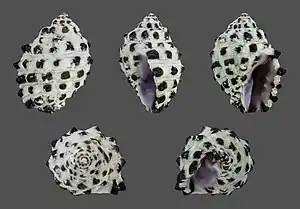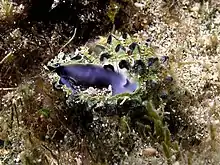Morula uva
Morula uva is a species of sea snail, a marine gastropod mollusk in the family Muricidae, the murex snails or rock snails.[1]

| Morula uva | |
|---|---|
 | |
| Morula uva | |
| Scientific classification | |
| Domain: | Eukaryota |
| Kingdom: | Animalia |
| Phylum: | Mollusca |
| Class: | Gastropoda |
| Subclass: | Caenogastropoda |
| Order: | Neogastropoda |
| Family: | Muricidae |
| Genus: | Morula |
| Species: | M. uva |
| Binomial name | |
| Morula uva (Röding, 1798) | |
| Synonyms[1] | |
| |
Description
Morula uva has a shell that can be either colored white or purple with rows of dark tubercles.[2] The mouth has a shade color of light violet with toothlike projections.[2] There are various sizes and lengths of M. uva, some can be 15mm by 9mm, others can be smaller.[2]
Distribution
Morula uva can be found in the tropical Indo-Pacific, which includes: the Red Sea and the Indian Ocean off Aldabra, Chagos, Madagascar, the Mascarene Basin and Tanzania, Iluka and Woolgoolga, New South Wales, and Hawaii.[3]
Biology
Morula uva are scavengers and hunt their prey, whether it be fellow marine gastropod mollusk or other.[2] In boulder zone habitats, M. uva competes with Drupa ricinus when feeding on Denropoma.[4] In mid-reef flat rocky substratum, where Dendropoma are less common, Morula uva feed mainly upon small individuals or small species of the herbivorous gastropod family Cerithiidae.[4]
Uses & Cultural Significance
Uses of Morula uva vary in their design of their shells.[5] Just like other gastropods, their shells are used for ornamental value or shaped into toys and models.[5] Another use is artists using the shells as a canvas and paint their creative ideas onto the shell and sell them to customers.[5]
References
- Morula uva (Röding, 1798). Retrieved through: World Register of Marine Species on 15 December 2018.
- Wales, Royal Zoological Society of New South (24 May 1954). "The Marine Zoologist, Volume 1, Number 2, 1954". http://aquaticcommons.org/id/eprint/16838. ISSN 0374-8944.
{{cite journal}}: External link in|journal= - Suratissa, Dissanayake Mudiyanselage; Rathnayake, Upaka (1 June 2017). "Effect of pollution on diversity of marine gastropods and its role in trophic structure at Nasese Shore, Suva, Fiji Islands". Journal of Asia-Pacific Biodiversity. 10 (2): 192–198. doi:10.1016/j.japb.2017.02.001. ISSN 2287-884X.
- Taylor, John D. (1 January 1978). "Habitats and diet of predatory gastropods at addu atoll, maldives". Journal of Experimental Marine Biology and Ecology. 31 (1): 83–103. doi:10.1016/0022-0981(78)90138-7. ISSN 0022-0981.
- Appukuttan, K. K.; Ramadoss, K. (2000), Pillai, V. N.; Menon, N. G. (eds.), Edible and ornamental gastropod resources, Kochi: CMFRI; Kochi, pp. 525–535, retrieved 13 March 2023
- Kilburn, R.N. & Rippey, E. (1982) Sea Shells of Southern Africa. Macmillan South Africa, Johannesburg, xi + 249 pp. page(s): 87
- Drivas, J. & M. Jay (1988). Coquillages de La Réunion et de l'île Maurice
- Houart R., Kilburn R.N. & Marais A.P. (2010) Muricidae. pp. 176–270, in: Marais A.P. & Seccombe A.D. (eds), Identification guide to the seashells of South Africa. Volume 1. Groenkloof: Centre for Molluscan Studies. 376 pp.
External links
- Illustration of Ricinula shells plate 395, legend p. 169. "Ricinula nodus. R. Morus Lamk. VII. 232. Vulgairment aussi la Mûre." is figure 6. M. Bruguiere (1791) Tableau encyclopédique et méthodique des trois règnes de la nature. Contenant l'helminthologie, ou les vers infusoires, les vers intestins, les vers mollusques, &c.; Paris.